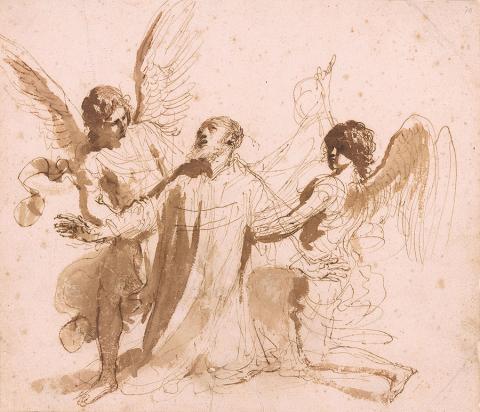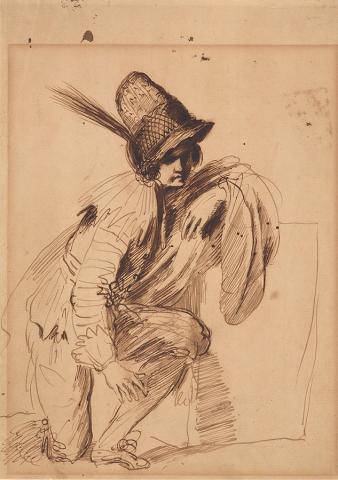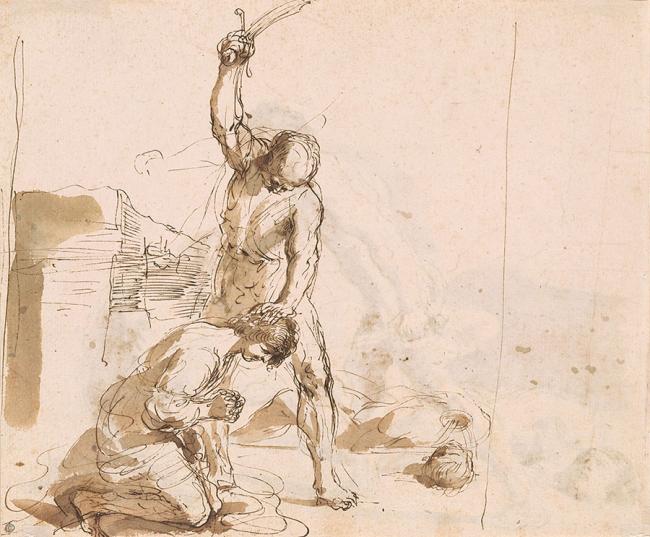An Interview with John Marciari on curating, the Morgan, and the draftsmanship of Guercino
Chalk, pen, wash, paper. Simple materials that create an overwhelmingly complex picture. Until February 2, 2020, the Morgan Library & Museum will exhibit Guercino: Virtuoso Draftsman, a reflection on choice pieces from the Morgan’s collection by Giovanni Francesco Barbieri, known as Guercino (1591–1666), who was “arguably the most interesting and diverse draftsman of the Italian Baroque era.” Recently, I had the opportunity to sit down with John Marciari, Charles W. Engelhard Curator at the Morgan, and pick his brain about what was so special about Guercino. We also discussed forgeries, the creative process, and what makes curating, and especially curating at the Morgan, such a compelling process.
Yona Benjamin: One gets the impression from the show that draftsmanship played a key role in Guercino’s activity as an artist. What was distinctive about Guercino’s drawing process?
John Marciari: With a lot of artists, Michelangelo, Raphael, and others, their drawings are sequential—steps towards a specific finished work. Not so with Guercino. Instead, when faced with a subject, he drew a lot of trials, not moving from one to the next in a process of refinement but instead imagining different schemes. When the time came to begin painting, I imagine him putting all his drawings on a table and then thinking, "Okay, what works, what doesn't?”
Yona Benjamin: Do we have any idea why he took this distinctive approach?
John Marciari: This could come in part from his being largely self-trained. He does not learn the academic process in the way someone working for Vasari in Florence would have done. The academic mode is a sort of orthopraxis, which makes sense in terms of working in a workshop. (In a workshop, students would divide labor and be part of the development process of a work, as well as copy their master’s pieces, thereby developing a standardized drawing process.--YB)
Yona Benjamin: So if Guercino is unlike other draftsmen, how do we judge his work, how do we determine what is and what is not a Guercino drawing? For instance, we have a piece in the collection called Young Man in a Tall Hat Kneeling on One Knee, which is noted as being “in the style of Guercino.” How can we make these calls with someone like Guercino?
John Marciari: In this case, we can compare to the original, which is housed in the Ashmolean Museum. Copies tend to flatten form, as if reproducing a two-dimensional image rather than projecting three-dimensional objects into two-dimensional form. It’s a good question, and I don’t know if Guercino is so different from others in this regard, but it can be very tricky to nail down an exact rubric for catching forgeries. You just need to get experience and learn to have a feel for these things. When I was a beginning graduate student at Yale, I was amazed at Egbert Havekamp-Begemann’s catalog of the drawing collection, in which so many drawings were labeled as copies of so and so or copies in the style of so and so, and I thought, how can he know? And in the fullness of time, many of the originals of these works were discovered and his observations were vindicated, he was proved right. And he was working before you had everything digitally available online. But the more you look at these things, the more you can notice the mistakes the copyists make. That’s why it is so important for us to have younger scholars come to work with us as fellows at the museum, so that they can learn these things that only experience can bring. And on a side note, we are going to have a scholars’ day on the Guercino exhibition, and I'll bring out some of the copies and we’ll play the game of who can spot them with people who really should know!
Yona Benjamin: Shifting a bit, I am curious as to how Guercino’s drawings, which are so compelling, so lively, and yet also perhaps understood as more ephemeral than paintings, came to be collected and treasured. How did drawings become an appreciated part of the world of fine arts?
John Marciari: The history of collecting drawings in Italy is long. Vasari (1511–1574), the proto-art historian, makes references to his book of drawings in his Lives of the Artists, but even a century earlier, Leon Battista Alberti made much of how the key moment in the work of art is that moment of creation, when an idea is manifest in the first design. This is usually in a drawing; so an interest in collecting those drawing develops. Similarly, Leonardo da Vinci often did not finish things, partly because the moment of creation was the central and crucial element for him. So these ideas are in the air for 200 years before Guercino.
There is nonetheless a shift in collecting practices that happens during Guercino’s lifetime in the 17th century, typified by Leopoldo de Medici, whose collection forms the bulk of the Uffizi galleries. Leopoldo began to collect in bulk, not only the fancy finished drawings but any sketch by an artist. This is paired with the continuing development of art-historical literature, which values the creative act. The writer and critic Filippo Baldinucci, for example, discusses this, and he was also Leopoldo’s curator and advisor. So we have a chicken-and-egg problem: does Baldanucci engage in this scholarship because he was immersed in Leopoldo’s collection, or did he advise Leopoldo to create this collection because of his own scholarly and aesthetic interest in the creative process? But either way this academic interest in the artistic process, seeing the creativity as it happened in the drawing rather than only in a finished work, has been around for some time and is an important part of how we come to appreciate draftsmanship.
Yona Benjamin: So, thinking of Guercino’s process allows us to glimpse this idea of valuing the moment of creation and the creative process rather than the obsession exclusively with the finished work.
John Marciari: Right, right. Guercino, when he gets a commission thinks about the different ways to do it. For Guercino, the act of an artist is not only to copy old forms, but to constantly rethink and improve the ways in which a subject can be understood and eventually painted. This imaginative process is where one artist can be better than another.
Yona Benjamin: And just as Guercino can be better than another artist, Guercino of the future can be better than Guercino of the past.
John Marciari: Yes, absolutely. Guercicno is an interesting case because his painting style, more so than the drawing style, makes deliberate evolutions. He is definitely concerned with this idea of constant improvement and his change in time and across styles.
Yona Benjamin: And engaging with his lively and dynamic drawings in the exhibit gives us a way to glimpse that about him.
John Marciari: Yes. That glimpse of an artist in the middle of the creative act, part of what the Morgan is all about. The drawings are akin to drafts of novels or symphonies with things crossed out. We also prize letters by writers and artists, and in fact have a couple in the Guercino exhibition. The idea of glimpsing the creative process, that's what unifies the Morgan collection and makes us different and distinct.
Yona Benjamin: And maybe even more accessible?
John Marciari: Maybe, but it's sort of a paradox. The drawings are less familiar to most visitors than are finished paintings, but they are perhaps more accessible. But they offer engagement with the human, with a real person trying to solve problems, rather than a finished work, which just is. There is a greater immediacy, perhaps because of ordinary materials like ink on paper.
Yona Benjamin: Fantastic. Pivoting again: This is a show that is about process and about how things fit together, so what was it like to curate this?
John Marciari: This started out just as a show to highlight one part of our rich holdings in the permanent collection. We could have just done a survey of Guercino—there has been so much said about him—but I wanted to say something new. And as we were going through the planning process, I began to think that some focus on his use of media, of ink and chalk and wash all working together, could became a common thread, one that I had not initially foreseen. Although many of these are quick sketches, Guercino seems at times to be striving for the most subtle effects possible with the simple mediums of red chalk, black chalk, white chalk, brown wash. At times the brown wash is so diluted it is almost like dirty water, yet he is using it to give you the most subtle intonation of a muscle, or the idea that this is not a flat form but something that exists in space. The drawings became richer every time we looked at them. That was something I hadn’t realized about Guercino until I began working on the project.
Yona Benjamin: How do you get that across?
John Marciari: I try to focus on treating these pieces as works of art, though it is sometimes hard to get that across without describing it evocatively. It's a challenge not to get too carried away, but sometimes it takes beautiful writing to describe beautiful objects. And for a show this small, I like the idea that it’s one curator taking you through, so I write the labels assuming that visitors read them in order. Curators are trying to tell stories, whether consciously or subconsciously, but in this show, I tried to keep coming back to the matter of technique.
Yona Benjamin: And this is a great opportunity to think about that. Because when you walk into the cube to see this show on Guercino’s drawings, you are already immersed in a discussion of process.
John Marciari: I agree, and to the last point, I love the cube because it is closed off, small, intimate. You are not rushing to see what is in the next room, to see as much as possible. I ask people what's your favorite work of art in the room, and what's the greatest work of art in the room. As I’ve said, that's the job of the curator, to tell stories and to get people to look more intently. Some people could walk into this show, see a bunch of saints and Christs, and be turned off. But the story I am telling with this show is not that, and I hope that the discussion of one person’s creative process is one with more universal appeal.
Yona Benjamin: What are your answers to your own questions? What is your favorite piece? What is the greatest piece?
John Marciari: If you are a museum curator, you need to ask what would be the most important piece for any museum to have, or in this case, which is the quintessential Guercino? With that question, I think you have to choose the double-sided Martyrdom of John and Paul, partially because it’s a two-fer! You get a picture of Guercino, of someone who works and reworks his ideas. It also has everything you want in a Guercino: it has the energy and movement, alternate positions in drafts, beautiful uses of wash to clarify form. Everything you want in a Guercino pen drawing, you have TWICE.
I personally also love the vision of St. Phillip Neri, the cover of the catalog. It has the psychology of the saint in ecstasy and how the angels respond to him; it has the movement, the abstraction of the lines, which seen in isolation do not depict a form, but our eyes resolve them. You also can see that at times Guercino is, well, not so good at drawing hands—they are lumpy, but he’s working quickly, and just for himself. It doesn't matter. It’s a great, lively, compelling drawing, regardless of one or another detail.
Guercino: Virtuoso Draftsman is on display at the Morgan until February 2, 2020. Come and get a glimpse of the artist at work, and see a quintessential example of the unique art we display at the Morgan.
Yona Benjamin
Columbia University Class of 2020
Communications and Marketing Department




